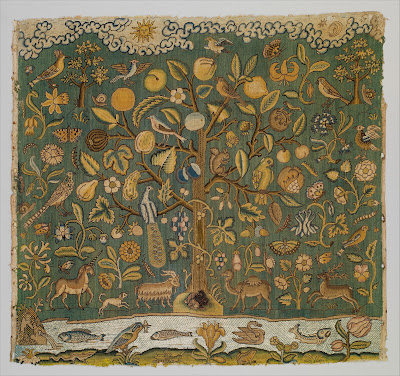We Are But One Thread
Tree of Life Tapestry
“We Are But One Thread”
by Rev. Linda M. Rhinehart Neas © 2018
Tapestries are weavings that often tell stories of a great event. We don’t have a tapestry here to demonstrate our interconnectedness, but, if we were to pull just one thread out of what weavers call the weft and warp, it pulls on all the other threads, taking them out of balance. If we pull on several threads, before long, our tapestry is a mess!
This is what is happening to us today. The various injustices, disasters, and crimes seen around the world are pulling all of us out of alignment. How do we fix this? The answer is simple - it is the answer that solves all problems, yet, it is the answer that is least likely to be thought of first. Love!
Yes, Love…the one virtue Jesus called us to emulate. The one virtue almost other faith paths call us to emulate. But exactly does this mean? We toss this word around in English willy-nilly. I love my children, my cat, my dog, my dress, your new hat, his new house, and on we go.
The writers of the Gospels however, wrote in Greek. In Greek there are several words for love; among them philia, eros and agape. When Jesus uses the word love, according to the writers of the Gospels, he uses derivatives of the word Agape.
Agape means “the highest form of love, charity" and "the love of God for man and of man for God." Interestingly, it is also, this type of love that is the foundation of all spiritual paths - Love one another - do no harm - care for you brother and sister - Love all creatures.
As a young girl in a Roman Catholic school, I was taught from the “Baltimore Catechism.” One of the teachings that has remained with me to this day is the call to “perform corporal and spiritual acts of mercy.” I was taught that when we do these acts of mercy, we demonstrate our love for God, our neighbor and ourselves. In the Jewish faith, this is called a Mitzvah…a blessing you give and get back in the giving.
What are the corporal and spiritual acts of mercy? Let me read what my catechism says…Yes, I still have it! While some of what is written within the pages is antiquated and doesn’t quite fit with my personal world view, however, I feel that it is still a good resource - a good reminder of where I came from and why I am heading in the direction I am heading. I find that it is also a way to show that there are many connections or threads, if you will, that unite all of us.
OK, so, the corporal works of mercy are: feed the hungry, give drink to the thirsty, clothe the naked, visit the imprisoned, shelter the homeless, visit the sick and bury the dead. The spiritual works of mercy, a written in the catechism, are: caution the sinner, instruct the ignorant, counsel the doubtful, comfort the sorrowful, bear wrongs patiently, forgive all injuries, and pray for the living and the dead.
These may sound like an impossible list, but in actuality, there isn’t anything on either of these lists that we cannot do, that we already do, in our own lives. Feed the hungry, give drink to the thirsty, shelter the homeless we do these things - now - when we collect for a food pantry, serve at a community meal, or raise money for Habitat for Humanity. Clothe the naked? We do this by taking unwanted, gently used clothes to a shelter. Visit the imprisoned, the sick. There are many in our community who are imprisoned by loneliness or illness; when we visit a sick, elderly shut-in, we do two corporal works at once! Imagine!
Spiritual acts of mercy are performed daily, also, often without our even thinking about it. Parents perform these acts all the time. Teaching children right from wrong…teaching them how to do anything! Helping them through troubled times, holding them in your arms or in your hearts when their hearts break for whatever reason. Forgiving their transgressions off the middle path and patiently waiting for them to see that you are also a fellow traveler on the road of life. Daily prayer offered for the living and the dead should be part of our routine. A simple mantra, said while driving, waiting in line, upon waking…Dear God, please bless friend and stranger, living and dead, Amen.
When we mindfully remember our interconnectedness to all, corporal and spiritual works of mercy become a natural part of our lives. Yes, they will know we are Christians by our Love!
Yet, even when we, ourselves, see that interconnectedness, even when we remember to love, there are still times we feel so lost, so frustrated, so angry. I believe this is because, going back to the metaphor of a tapestry, we have been pulled out of warp. Our world, through the media, through conversations, through our day to day trials, pulls on the threads of our life. Being pulled into states of despair because of world conditions; pulled into fear of those who are different from us and pulled into apathy, which makes it difficult to stay straight and strong in the tapestry of Life.
The Great Commandment - to Love one another - is found in all faith paths. Love and compassion go hand in hand. Compassion is Love put into action. The Dalai Lama reminds us that, “Compassion is not religious business, it is human business, it is not luxury, it is essential for our own peace and mental stability, it is essential for human survival.” By staying focused, actively and mindfully, on strengthening our connections to others, we create beautiful texture and design in the Tapestry of our lives.
Karen Armstrong, the British author and creator of the Charter for Compassion, a document that urges the people and religions of the world to embrace the core value of compassion, works tirelessly to promote an awareness of our interdependence on each other as human beings. She is quoted as saying, “If we want to create a viable, peaceful world, we've got to integrate compassion into the gritty realities of 21st century life.” She reminds us in her writings that Compassion is not pity or feeling sorry for people. She also suggests that we, “…use our stories to encourage listening to one another and to hear not just the good news, but also the pain that lies at the back of a lot of people's stories and histories,” because it is in learning about the pain, the suffering and our connection to it that we are able to pull our weft and warp back into alignment.
“We are all interconnected.” “We are One” Hindus say, “There is no rooted differences between us.” Islam teaches, “All creatures are the family of God.” In the Shinto sacred places of Japan, it is said, “Do not forget that the world is one great family ... Regard Heaven as your father, Earth as your mother, and all things as your brothers and sisters.” And, the Native American belief is that “The Great Spirit is the Father, Earth the Mother. With all things and in all things, we are relatives.” “We are but one thread.”
Let me share a poem -
The Weaver
She sits before her loom,
inspecting the weft and warp.
Each thread - a life
Each life - a connection
She sits before her loom,
weaving designs and patterns.
Each connection - a knot
Each knot - an eternity
She sits before her loom
-
creating...
© 2013 LMRN
May we all come to recognize the weft and warp of our life tapestries, seeing the connections we have, each to the other. May those around us know we are Christians by our Love and May the unconditional Love of the Master Weaver bring us Grace- to each of us and to our world.
Blessings to all!




Comments